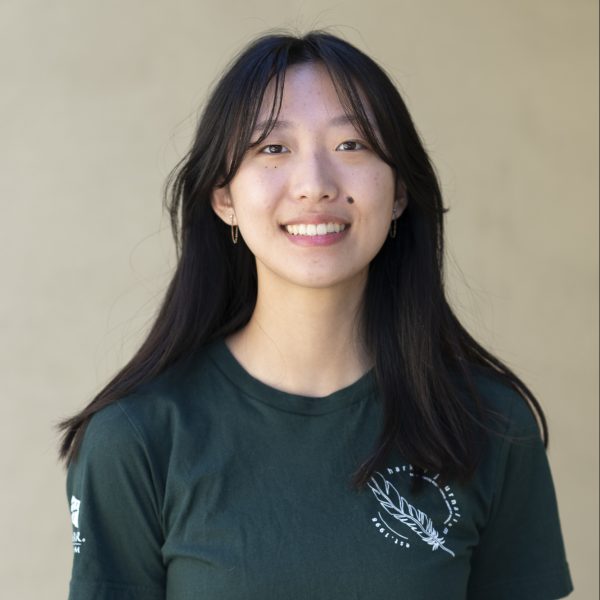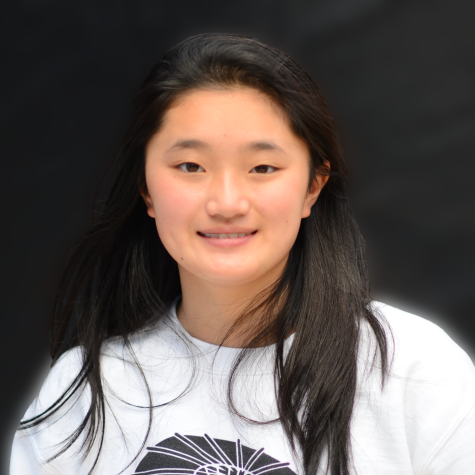Humans of Harker: Pinpointing passions
Ananya Bammi connects her separate interests by using her voice and giving her all
“I used to think that I shouldn’t try if I’m not already good at it, which hurt me because I didn’t put my best effort into some things. If I go in with an ’all or nothing’ mindset, it helps motivate me to try my best at the things that I do,” Ananya Bammi (12) said.
Colored thumbtacks dot the wall, piercing through the fabric behind them. White, jagged outlines trace around labeled regions of land and water: North America, Europe, the Atlantic Ocean. Thinner lines delicately map out countries, states, rivers. Ananya Bammi (12) quickly scans the world map for the answer to her friend’s trivia question, her eyes lighting up with excitement as she confidently points to a country in Africa and receives affirmation that her answer is correct.
During the uncertain, trying times of the pandemic, many sought solace in new hobbies such as jigsaw puzzles, baking and gardening. Meanwhile, Ananya discovered a newfound passion for online geography trivia. Over time, she has come to appreciate the value of geography knowledge and has committed many locations to memory. Her knowledge has equipped her with a deeper understanding of global events and their interconnected nature.
“It’s fun, because [geography’s] something that I can apply in my life,” Ananya said. “If I wake up in the morning and read a news article, I’ll actually know more about what’s going on.”
Ananya’s devotion to geography and trivia is evident to those around her. Amrita Pasupathy (12), who has known Ananya since lower school, admires the amount of time she has invested in expanding her knowledge through trivia over the years.
“Her level of dedication is insane,” Amrita said. “She uses a website where you do timed quizzes and have to answer prompts, and you just do more to get better. Over COVID, she put in so many hours. You can ask her anything and she just has the answer — it amazes me because it requires so much memorization.”
Just as she connects geography with her understanding of real-world events, Ananya finds that two other prominent aspects of her life relate to each other in many ways: art and STEM. Within the realm of biomedical engineering, for example, she believes knowledge of art will help her design more innovative solutions to improve human health. She reflects on how the two subjects inform one another in their creative process and how they mutually enhance each other.
“I’ve found that [art] fits in with other things in my life,” Ananya said. “The art process is very similar to an engineering process. You start with your idea, and then you have to come up with a process and design, which is applicable to both sides. There’s a lot of science that can go into art, and the other way around — I’m also interested in biology, and those two subjects connect really easily: having knowledge of the body, the skeleton and muscles will really help with my drawings.”
In art, Ananya allows her creativity to flourish unrestricted by guidelines. In contemplating the connection between art and STEM, Ananya has discovered parallels between the creative process in art and the coding process in computer science.
“It’s very liberating — there are no rules,” Ananya said. “With art, you can do whatever you want. That also translates to other things, like in CS, there’s not one way you can code, you can be creative in your approach, which is the same as in art. Even if I’m trying to draw a specific image, there’s so many ways I can go about that.”
Despite her bold, experimental approach to art and other activities, Ananya has struggled with embracing risks. However, by taking small, steady steps like vocalizing her thoughts in the classroom, she has grown more confident in taking calculated risks.
“Sometimes I do things in a low-risk, low-reward situation as opposed to a more high-risk, high-reward situation,” Ananya said. “Something I’ve been trying to get better at is stopping fear from stopping me in terms of just small things like going to office hours more often and taking more chances.”
Over the course of high school, Ananya has overcome her fear of taking risks, and her progress shows in the classroom. Upper school biology teacher Eric Johnson recalls their first interactions with Ananya and notes the striking transformation in her confidence and willingness to put herself out there.
“Ananya at first was quiet,” Johnson said. “But as time went on, she would come into my class and office hours, she would hang out after school. That’s where I got to see her personality. She definitely was someone who would make efforts to come talk to me. I think she could really communicate her voice. Standing out and having a voice is really important in science.”
In addition to expressing herself in a classroom environment, Ananya enjoys starting conversations within her tight-knit group of friends and sharing contrasting viewpoints. Close friend Lucy Feng (12) reflects on the value of having a friend like Ananya.
“She’s a lover of discussion, in the sense that she will argue against you, but not in a ‘I think you’re wrong’ sort of way,” Lucy said. “It’s just different opinions. She’s easy to agree with. She really likes to bring up all sorts of conversations. I feel like if every friend group had a character similar to [Ananya], the friend group would be better.”
From memorizing geographical locations to exploring science through an artistic lens, Ananya has found that dedication is the key to fulfillment in all aspects of her life. She applies this overarching principle to every task she undertakes, ensuring that she gives her best effort to each of her endeavors.
“I used to think that I shouldn’t try if I’m not already good at it, which hurt me because I didn’t put my best effort into some things,” Ananya said. “If I go in with an ‘all or nothing’ mindset, it helps motivate me to try my best at the things that I do.”

Claire Su (12) is the co-editor-in-chief of the TALON Yearbook, and this is her fourth year on staff. This year, Claire hopes to cover a broader variety...

Katie Wang (12) is the photo editor of the TALON Yearbook, and this is her fourth year on staff. This year, Katie looks forward to photographing with new...




![LALC Vice President of External Affairs Raeanne Li (11) explains the International Phonetic Alphabet to attendees. "We decided to have more fun topics this year instead of just talking about the same things every year so our older members can also [enjoy],” Raeanne said.](https://harkeraquila.com/wp-content/uploads/2025/10/DSC_4627-1200x795.jpg)


















![“[Building nerf blasters] became this outlet of creativity for me that hasn't been matched by anything else. The process [of] making a build complete to your desire is such a painstakingly difficult process, but I've had to learn from [the skills needed from] soldering to proper painting. There's so many different options for everything, if you think about it, it exists. The best part is [that] if it doesn't exist, you can build it yourself," Ishaan Parate said.](https://harkeraquila.com/wp-content/uploads/2022/08/DSC_8149-900x604.jpg)




![“When I came into high school, I was ready to be a follower. But DECA was a game changer for me. It helped me overcome my fear of public speaking, and it's played such a major role in who I've become today. To be able to successfully lead a chapter of 150 students, an officer team and be one of the upperclassmen I once really admired is something I'm [really] proud of,” Anvitha Tummala ('21) said.](https://harkeraquila.com/wp-content/uploads/2021/07/Screen-Shot-2021-07-25-at-9.50.05-AM-900x594.png)







![“I think getting up in the morning and having a sense of purpose [is exciting]. I think without a certain amount of drive, life is kind of obsolete and mundane, and I think having that every single day is what makes each day unique and kind of makes life exciting,” Neymika Jain (12) said.](https://harkeraquila.com/wp-content/uploads/2017/06/Screen-Shot-2017-06-03-at-4.54.16-PM.png)








![“My slogan is ‘slow feet, don’t eat, and I’m hungry.’ You need to run fast to get where you are–you aren't going to get those championships if you aren't fast,” Angel Cervantes (12) said. “I want to do well in school on my tests and in track and win championships for my team. I live by that, [and] I can do that anywhere: in the classroom or on the field.”](https://harkeraquila.com/wp-content/uploads/2018/06/DSC5146-900x601.jpg)
![“[Volleyball has] taught me how to fall correctly, and another thing it taught is that you don’t have to be the best at something to be good at it. If you just hit the ball in a smart way, then it still scores points and you’re good at it. You could be a background player and still make a much bigger impact on the team than you would think,” Anya Gert (’20) said.](https://harkeraquila.com/wp-content/uploads/2020/06/AnnaGert_JinTuan_HoHPhotoEdited-600x900.jpeg)

![“I'm not nearly there yet, but [my confidence has] definitely been getting better since I was pretty shy and timid coming into Harker my freshman year. I know that there's a lot of people that are really confident in what they do, and I really admire them. Everyone's so driven and that has really pushed me to kind of try to find my own place in high school and be more confident,” Alyssa Huang (’20) said.](https://harkeraquila.com/wp-content/uploads/2020/06/AlyssaHuang_EmilyChen_HoHPhoto-900x749.jpeg)



